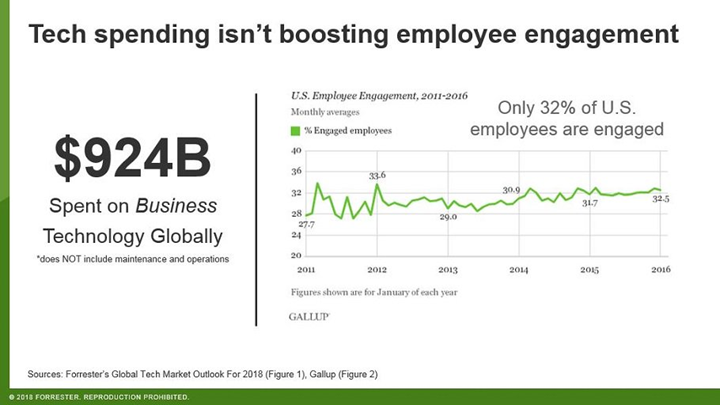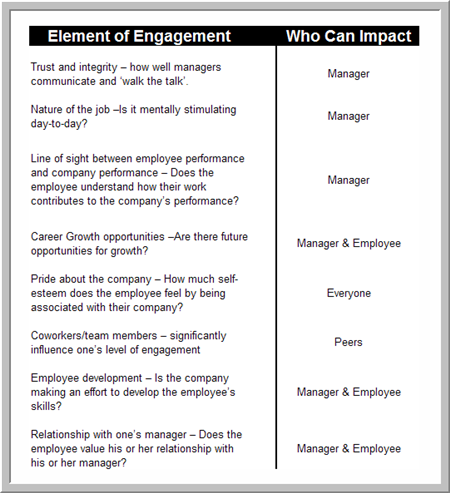I know I said a few weeks back I wouldn’t post again about employee engagement. Technically I said I wouldn’t post on the importance of employee engagement and this is a post about how to actually increase engagement which is a bit different. This post is about how almost all of the advice out there on employee engagement is wrong. I do see a few people pulling at the threads of the real root cause of disengagement, but not nearly enough.
So, to once again demonstrate the ongoing stupidity around employee engagement and the fact that almost $1 TRILLION has been spent on it in the last 5 years with ZERO impact, I am going to remix, rehash and old post. (FYI: I am not making up that number. That’s from Forrester.)
I’d even go a bit deeper and say it’s been longer than that and even more money has been thrown at it.
Targeting the Wrong Audience
What follows is a bit of a remix/rehash of a post from… wait for it… 2007! Yeah… not much has changed in 11 years. I had to check that the post I referenced was still available.
I started by referencing a nice post on employee engagement from systematicHR where they brought together some of the various opinions and survey results on what engages employees. They identified eight (8) common drivers of employee engagement. When I first read the list it hit me that most clients target programs at their employees to increase engagement and worry almost exclusively about influencing the employee. And THAT is the problem IMO.
The chart below lists the eight (8) elements identified by systematicHR that drive employee engagement and I added my opinion on who has the most impact on positive engagement outcome.
See the pattern?
If we want to impact employee engagement we need to impact the manager.
Once again, we start by trying to fix the symptom instead of the root cause.
Don’t get me wrong. Employees have a role. Employees have a responsibility to grow and learn and be adaptable as opportunities arise. Engagement is a two-way street, a good manager will provide the appropriate room for growth and engagement and open the door for their staff. But the employee must make the effort to walk through the door.
When developing your engagement plan – start and finish – with your managers.







April 24, 2018 at 10:50 am
Paul:
I share your frustration! Engagement Programs are typically “sold” by companies that are driven by getting engagement awards out the door and not much more. Beyond the managers, who I agree need to be educated and motivated to engage in the engagement program, Senior Management needs all of that and more. The bottom up approach simply does not work especially long-term.
April 24, 2018 at 8:21 pm
Great article! One clarification. I assume that since managers are the key to employee engagement, that means managers at all levels. So, that could be managers, directors, VPs, SVPs, etc.
With that said, I wonder if the employee engagement dollars were funneled into leadership training, we’d see an impact. Too many people managers don’t have the skills needed to lead and ultimately influence engagement.
April 27, 2018 at 7:39 am
Yes Andi – I’m lumping “management” into a common class – those that have people reporting to them and are responsible for guiding their performance.
I also think training and selection is huge problem and one that should be addressed as you indicated. I think we could move 50% of the dollars from “engagement” into selecting and training better managers and get a huge increase in our employee engagement.
Thanks for engaging!
April 24, 2018 at 10:46 pm
Nice post and I certainly admire your passion for this…BUT…I must confess I disagree that Engagement should “start and finish” with Management.
I believe the answer to ‘who drives employee engagement?’ is found the question.
After all, let think about who is responsible for;
• The upkeep of your car… You or the mechanic?
• What you order at a restaurant… You or your server?
• Catching your flight… You or the pilot?
• How you spend your money… You or your financial advisor?
While the mechanic, server, pilot and financial adviser are significant participants in the examples above, the responsibility for the outcome falls on each of us to get it right.
So too with Engagement. Don’t get me wrong, Management play a huge part and should champion and support the employees but the individuals should be seen as (and empowered to be) the catalyst that drive it forward.
April 27, 2018 at 7:44 am
Thanks for engaging Shea. And I also believe engagement is a two-way street and employees who aren’t taking some ownership in the process won’t engage regardless of the number of foosball tables and beer fridays the company has.
But why I think management is the alpha and omega is this…
If my mechanic won’t tell me what needs to be done can I be a partner in the upkeep in my car?
If my financial manager won’t return my calls or simply shoves the same plan in front of me as she did to her last client will I be successful?
In each of the cases you provide (except pilot one – that’s much more complex situation) in order for me to have a successful outcome I have to have a person who wants to help me. It starts there. I need a manager to reach out and ask – “What do you need?” Just like I need a financial advisor to ask what my investment goals are.
In an organization managers enable engagement. No matter how much I WANT to be engaged if my managers is checked out I lose and need to leave.
That is why I say it starts with the manager – they have to open the door. As I said in the post – the employee has to walk through it.
Thanks for engaging!